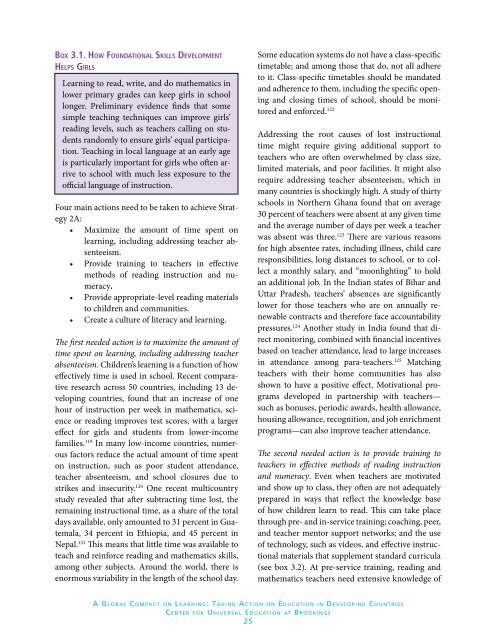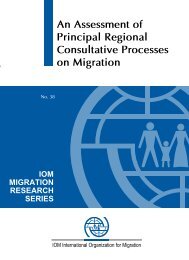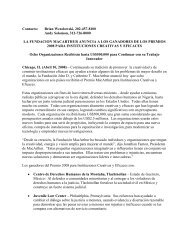A Global Compact on Learning - Brookings Institution
A Global Compact on Learning - Brookings Institution
A Global Compact on Learning - Brookings Institution
You also want an ePaper? Increase the reach of your titles
YUMPU automatically turns print PDFs into web optimized ePapers that Google loves.
Box 3.1. How Foundati<strong>on</strong>al Skills Development<br />
Helps Girls<br />
<strong>Learning</strong> to read, write, and do mathematics in<br />
lower primary grades can keep girls in school<br />
l<strong>on</strong>ger. Preliminary evidence finds that some<br />
simple teaching techniques can improve girls’<br />
reading levels, such as teachers calling <strong>on</strong> students<br />
randomly to ensure girls’ equal participati<strong>on</strong>.<br />
Teaching in local language at an early age<br />
is particularly important for girls who often arrive<br />
to school with much less exposure to the<br />
official language of instructi<strong>on</strong>.<br />
Four main acti<strong>on</strong>s need to be taken to achieve Strategy<br />
2A:<br />
• Maximize the amount of time spent <strong>on</strong><br />
learning, including addressing teacher absenteeism.<br />
• Provide training to teachers in effective<br />
methods of reading instructi<strong>on</strong> and numeracy.<br />
• Provide appropriate-level reading materials<br />
to children and communities.<br />
• Create a culture of literacy and learning.<br />
The first needed acti<strong>on</strong> is to maximize the amount of<br />
time spent <strong>on</strong> learning, including addressing teacher<br />
absenteeism. Children’s learning is a functi<strong>on</strong> of how<br />
effectively time is used in school. Recent comparative<br />
research across 50 countries, including 13 developing<br />
countries, found that an increase of <strong>on</strong>e<br />
hour of instructi<strong>on</strong> per week in mathematics, science<br />
or reading improves test scores, with a larger<br />
effect for girls and students from lower-income<br />
families. 119 In many low-income countries, numerous<br />
factors reduce the actual amount of time spent<br />
<strong>on</strong> instructi<strong>on</strong>, such as poor student attendance,<br />
teacher absenteeism, and school closures due to<br />
strikes and insecurity. 120 One recent multicountry<br />
study revealed that after subtracting time lost, the<br />
remaining instructi<strong>on</strong>al time, as a share of the total<br />
days available, <strong>on</strong>ly amounted to 31 percent in Guatemala,<br />
34 percent in Ethiopia, and 45 percent in<br />
Nepal. 121 This means that little time was available to<br />
teach and reinforce reading and mathematics skills,<br />
am<strong>on</strong>g other subjects. Around the world, there is<br />
enormous variability in the length of the school day.<br />
Some educati<strong>on</strong> systems do not have a class-specific<br />
timetable; and am<strong>on</strong>g those that do, not all adhere<br />
to it. Class-specific timetables should be mandated<br />
and adherence to them, including the specific opening<br />
and closing times of school, should be m<strong>on</strong>itored<br />
and enforced. 122<br />
Addressing the root causes of lost instructi<strong>on</strong>al<br />
time might require giving additi<strong>on</strong>al support to<br />
teachers who are often overwhelmed by class size,<br />
limited materials, and poor facilities. It might also<br />
require addressing teacher absenteeism, which in<br />
many countries is shockingly high. A study of thirty<br />
schools in Northern Ghana found that <strong>on</strong> average<br />
30 percent of teachers were absent at any given time<br />
and the average number of days per week a teacher<br />
was absent was three. 123 There are various reas<strong>on</strong>s<br />
for high absentee rates, including illness, child care<br />
resp<strong>on</strong>sibilities, l<strong>on</strong>g distances to school, or to collect<br />
a m<strong>on</strong>thly salary, and “mo<strong>on</strong>lighting” to hold<br />
an additi<strong>on</strong>al job. In the Indian states of Bihar and<br />
Uttar Pradesh, teachers’ absences are significantly<br />
lower for those teachers who are <strong>on</strong> annually renewable<br />
c<strong>on</strong>tracts and therefore face accountability<br />
pressures. 124 Another study in India found that direct<br />
m<strong>on</strong>itoring, combined with financial incentives<br />
based <strong>on</strong> teacher attendance, lead to large increases<br />
in attendance am<strong>on</strong>g para-teachers. 125 Matching<br />
teachers with their home communities has also<br />
shown to have a positive effect. Motivati<strong>on</strong>al programs<br />
developed in partnership with teachers—<br />
such as b<strong>on</strong>uses, periodic awards, health allowance,<br />
housing allowance, recogniti<strong>on</strong>, and job enrichment<br />
programs—can also improve teacher attendance.<br />
The sec<strong>on</strong>d needed acti<strong>on</strong> is to provide training to<br />
teachers in effective methods of reading instructi<strong>on</strong><br />
and numeracy. Even when teachers are motivated<br />
and show up to class, they often are not adequately<br />
prepared in ways that reflect the knowledge base<br />
of how children learn to read. This can take place<br />
through pre- and in-service training; coaching, peer,<br />
and teacher mentor support networks; and the use<br />
of technology, such as videos, and effective instructi<strong>on</strong>al<br />
materials that supplement standard curricula<br />
(see box 3.2). At pre-service training, reading and<br />
mathematics teachers need extensive knowledge of<br />
A <str<strong>on</strong>g>Global</str<strong>on</strong>g> Compa c t <strong>on</strong> <strong>Learning</strong>: Taking Acti<strong>on</strong> <strong>on</strong> Educat i o n in Developing Countries<br />
C e n t e r for Universal Educat i o n at <strong>Brookings</strong><br />
25






